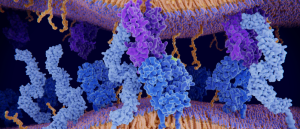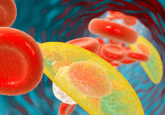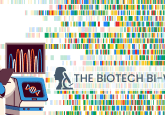The biotech bi-weekly: organoids take to the stars, SPR increases in sensitivity and 3D printing brings tunability to oral drug delivery

In this edition, a new partnership is taking vascularized organoids to the international space station, new products have been developed to conduct highly sensitive SPR and high-throughput drug development, and a recently published paper shows that a new delivery approach could improve the penetrance of cancer therapies.
Products
High-throughput SPR system delivers improved sensitivity
Carterra Inc. (UT, USA), a biotech company focused on high-throughput delivery, has released its latest high-throughput surface plasmon resonance (SPR) instrument, Carterra Ultra™, improving on its previous platform’s sensitivity to detect molecules as small as 100 Daltons. This sensitivity enables small molecule applications while retaining practical features such as high throughput and low sample volume input requirements.
The platform also offers strong thermal control that enables it to measure interactions at temperatures as low as 10°C. The team at Carterra report that it will be useful for generating the vast quantity of binding data needed to train AI models and to accelerate small molecule drug discovery.
New package offers end-to-end development of AAV-based gene therapies, from AI-informed drug design to AAV growth
A new suite of tools has been released with the development of adeno-associated viral (AAV) gene therapies in mind. Named AAV Edge by synthetic biology company Asimov (MA, USA), the suite includes AI-designed tissue-specific promoters, which have been validated in animals; DNA sequence optimization for increased in vivo expression; and gene-of-interest (GOI) silencing tools for use during the production process to minimize GOI toxicity, all to aid in the design of payloads for gene therapies.
The suite also includes tools for the production stages, including a transient transfection-based AAV manufacturing system utilizing GMP-banked HEK293 host cells among other features.
Updated: lab software for high-throughput experimentation, chemistry manufacturing and control, and drug development.
Informatics company ADC/Labs (Ontario, Canada) has released the 2024 edition of its analytical and chemical knowledge management software: Spectrus. The system combines desktop software and browser-based applications to process analytical data from techniques including LC/MS, NMR, GC/MS, HPLC, Raman and more, even when collected using machines from different vendors.
The update includes advances in their Luminata® and Katalyst D2D® software that add support for accelerated stability studies used to determine shelf life and drug expiry, improve integration with third-party software systems, and introduce integrated AI tools to make the use of these technologies simpler.
 Keeping it SIMPL: investigating protein–protein interactions with Igor Stagljar
Keeping it SIMPL: investigating protein–protein interactions with Igor Stagljar
Igor Stagljar’s group is one of the leading labs in the field of proteomics and chemical genomics, developing high-throughput technologies to facilitate the study of protein–protein interactions (PPIs) with a focus on human membrane proteins involved in cancer. In this interview, we discuss why targeting disease-associated PPIs is an attractive option for drug discovery and development, what technologies Stagljar and his lab have developed and where PPI research is headed in the future.
Partnerships
Vascularized organoids take to the stars
A collaboration between Ronawk (KS, USA), Micro-gRX and the University of Florida (both FL, USA) has set out to investigate the effect of microgravity on the remodeling of heart and skin vasculature. The project will customize Ronawk’s Bio-Block technology, which mimics cells’ in vivo environment and facilitates organoid growth, to promote the development of microchannels throughout organoids that simulate vasculature.
With these vascularized organoids, the team – led by Maddalena Parafati (University of Florida) and composed of researchers from her institution and Micro-GX – hopes to learn more about vascular remodeling during aging, theorizing that the impact of microgravity and radiation may mimic this process. Furthermore, they intend to determine the quality of extracellular vesicles, used by cells as a method of intercellular communication, produced by organoids in space, ultimately uncovering how to protect astronauts in space and improve vascular health on earth.
Informatics and wet lab science collide to produce an armory of lead candidates for CAD
A novel molecular target in coronary artery disease (CAD), identified by the endotype-specific biomarker discovery company PlaqueTec (Cambridge, UK), has been utilized in a virtual cheminformatics screen to identify potential drug candidates. These small molecule candidates have subsequently been screened in a bespoke cell-based assay developed by RxCelerate (Cambridge, UK), a provider of out-sourced services for drug discovery and development.
The assay has enabled researchers to further characterize the lead candidates from the initial virtual drug screen. The novel CAD target is still being validated in PlaqueTec’s ongoing BIOPATTERN trial. Once validation is complete, the team will investigate additional lead candidates identified in the trial.
3D-printing-based partnership to enable the delivery of highly customizable oral drug delivery solutions to the pharmaceutical market
The CDMO Adare Pharma Solutions (PA, USA) has partnered with Laxxon Medical (Jena, Germany) to combine their expertise and, using the Screen-Printed Innovative Drug (SPID®) Technology exclusively licensed from Exentis Group (Stetten, Switzerland) to Laxxon, enable Laxxon to continue their development of innovative oral dosing forms for their own pipeline of drug candidates and for their clients – but on a larger scale at Adare’s site in Pessano (Milan, Italy).
What does innovative oral dosage forms mean? Essentially, they will use 3D-printing technology to produce a wide variety of customizable tablets with different features, such as: multiple active ingredients in different compartments, tunable release profiles depending on the target you would like to dose and variable release for different active ingredients.
 Extraterrestrial agriculture: plant cultivation in space
Extraterrestrial agriculture: plant cultivation in space
Researchers are using various techniques and technologies to study how plants grow in extraterrestrial conditions with the hopes of sustaining longer missions for exploring deep space as well as being able to one day cultivate crops on other planets.
People and publications
Academic funding secured to broadly treat bloodborne pathogens transmitted during battle
The Wyss Institute for Biologically Inspired Engineering at Harvard University (MA, USA) has received up to $12M from the Defense Advanced Research Projects Agency’s (DARPA; MD, USA) new SHIELD program. This program’s objective is to develop a prophylactic treatment for trauma victims in combat scenarios that can kill and protect against numerous bloodborne pathogens for up to seven days, limiting morbidity and mortality.
The time it takes to identify specific pathogens responsible for a bloodstream infection, particularly one present in a physical trauma victim, can be too long to prevent significant harm coming to the patient. The Wyss Institute researchers have won the support of DARPA through their suggested approach to this problem, which combines ‘FcMBL-mediated pathogen-binding’ and ‘macrophage-activating cellular backpacks’, to broadly treat both fungal and bacterial bloodborne pathogens.
New delivery system improves penetrance of target molecule into tumors
A pressure-enabled drug delivery (PEDD) method, developed by TriSalus Life Sciences (CO, USA), has been reported in the Journal of Vascular and Interventional Radiology as improving the delivery of glass microspheres (GM) into liver tumors in transgenic porcine models compared to conventional delivery methods.
GMs were fluorescently labelled and delivered – either by conventional microcatheter delivery or the PEDD method via the TriNav infusion system – to selective infusions and lobar infusions, which are delivered more generally to a larger portion of the liver. There was a 117% increase in tumor penetrance in the lobar infusions and a 39% increase in the selective infusions.





